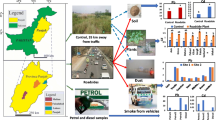Abstract
The leaves of roadside Rhododendron pulchrum Sweet were examined as a bioindicator of traffic-related heavy metal pollution in Okayama. Total contents of heavy metals in roadside soil and the R. pulchrum leaves were determined. Results of correlation analyses showed significant correlations among Pb, Ni, and Zn contents of roadside soil and leaf samples. These results suggest that R. pulchrum is a useful bioindicator of heavy metal pollution in traffic areas. To identify traffic-related heavy metal pollution sources, traffic-related materials such as tires, asphalt pavement, and road paint were collected and analyzed. The results of analyses of our data show that Zn is emitted mainly from the abrasion of tires; Cr is emitted mainly from wear of the asphalt pavement. Furthermore, the respective lead isotope ratios in R. pulchrum leaves, soil, roadside dust, and traffic-related materials were measured using inductively coupled plasma mass spectrometry. The isotopic compositions of lead in R. pulchrum leaves were 207Pb/206Pb = 0.861–0.871 and 208Pb/206Pb = 2.093–2.127, which agrees well with ratios in automobile wheel balance weights, suggesting that lead-containing products associated with automobiles, such as wheel balance weights, contribute to traffic-related lead pollution.
Similar content being viewed by others
References
Aksoy, A., Sahin, U., & Duman, F. (2000). Robinia pseudo-acacia L. as a possible biomonitor of heavy metal pollution in Kayseri. Turkish Journal of Botany, 24, 279–284.
Asami, T. (1988). Soil pollution by metals from mining and smelting activities. In W. Salomons, & U. Frőstner (Eds.) Chemistry and biology of solid waste (pp. 143–169). Tokyo: Springer-Verlag.
Cumming, G. L., & Richards, J. R. (1975). Ore lead isotope ratios in a continuously changing earth. Earth and Planetary Science Letters, 28, 155–171.
Environmental Agency, Japan (1973). Testing methods for metals in industrial wastes, Notification No. 13 of the Environmental Agency (in Japanese).
Flanagan, J. T., Wade, K. J., Currie, A., & Curtis, D. J. (1980). The deposition of lead and zinc from traffic pollution on two roadside shrubs. Environmental Pollution, 1, 71–78.
Garcia, R., Ma, C. D. T., Padilla, H., Belmont, R., Azpra, E., Arcega-Cabrera, F., et al. (2006). Measurement of chemical elements in rain from Rancho Viejo, a rural wooded area in the State of Mexico, Mexico. Atmospheric Environment, 40, 6088–6100.
Hol, P. J., Gawron, A. H., Hurst, J. M., Yeager, A. R., van Galen, D. A., & Isrenn, R. (1997). Investigation of lead and cadmium levels in roadside rhododendron in Bergen, Norway utilizing multivariate analysis. Microchemical Journal, 55, 169–178.
Mingorance, M. D., Valdés, B., & Rossini Oliva, S. (2007). Strategies of heavy metal uptake by plants growing under industrial emissions. Environment International, 33, 514–520.
Möller, A., Müller, H. W., Abdullah, A., Abdelgawad, G., & Utermann, J. (2005). Urban soil pollution in Damascus, Syria: Concentrations and patterns of heavy metals in the soils of the Damascus Ghouta. Geoderma, 124, 63–71.
Mukai, H., Furuta, N., Fujii, T., Ambe, Y., Sakamoto, K., & Hashimoto, Y. (1993). Characterization of sources of lead in the urban air of Asia using ratios of stable lead isotope. Environmental Science and Technology, 27, 1347–1356.
Nimis, P. L., Castello, M., & Perotti, M. (1993). Lichens as bioindicators of heavy metal pollution: A case study at La Spezia (N. Italy). In B. Markert (Ed.) Plants as biomonitors—Indicators for heavy metals in the terrestrial environment (pp. 265–284). Weinheim: VCH.
Onianwa, P. C., & Adoghe, J. O. (1997). Heavy-metal content of roadside dust gutter sediments in Ibadan, Nigeria. Environment International, 23, 873–877.
Peterson, P. J. (1969). The distribution of zinc-65 in Agrostis tenuis Sibth. and A. stolonifera L. tissues. Journal of Experimental Botany, 20, 863–875.
Rambæk, J. P., & Steinnes, E. (1980). Atmospheric deposition of heavy metals studied by analysis of moss samples using neutron activation analysis and atomic absorption spectrometry, Nuclear Methods in Environmental and Energy Research, Conf-800433, US DOE, 175–180.
Rossini Oliva, S., & Espinosa, A. H. F. (2007). Monitoring of heavy metals in topsoils, atmospheric particles and plant leaves to identify possible contamination sources. Microchemical Journal, 86, 131–139.
Shinya, M., Funasaka, K., Katahira, K., & Matsui, S. (2006). Determination of lead source in urban road runoff due to automobile traffic. Journal of Japan Society on Water Environment, 29(11), 693–698.
Shiraishi, S., Watanabe, I., & Kuno, K. (2002). Heavy metal accumulation in the street dust, roadside soil and roadside tree leaves near by main streets in Tokyo, Japan. Journal of Environmental Chemistry, 12(4), 829–837.
Walkenhorst, A., Hagemeyer, J., & Breckle, S. W. (1993). Passive monitoring of airborne pollutants, particularly trace metals, with tree bark. In B. Markert (Ed.) Plants as biomonitors—Indicators for heavy metals in the terrestrial environment (pp. 523–540). Weinheim: VCH.
Wedepohl, K. H. (1995). The composition of the continental crust. Geochimica et Cosmochimica Acta, 59, 1217–1232.
Zu, Y., Li, Y., Schvartz, C., Langlade, L., & Fan, L. (2004). Accumulation of Pb, Cd, Cu and Zn in plants and hyperaccumulator choice in Lanping lead-zinc mine area, China. Environment International, 30, 567–576.
Author information
Authors and Affiliations
Corresponding author
Rights and permissions
About this article
Cite this article
Suzuki, K., Yabuki, T. & Ono, Y. Roadside Rhododendron pulchrum leaves as bioindicators of heavy metal pollution in traffic areas of Okayama, Japan. Environ Monit Assess 149, 133–141 (2009). https://doi.org/10.1007/s10661-008-0188-7
Received:
Accepted:
Published:
Issue Date:
DOI: https://doi.org/10.1007/s10661-008-0188-7




